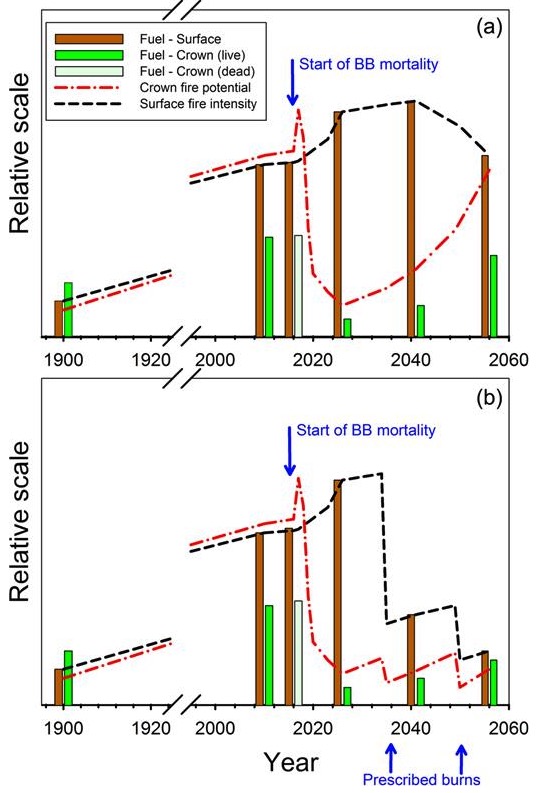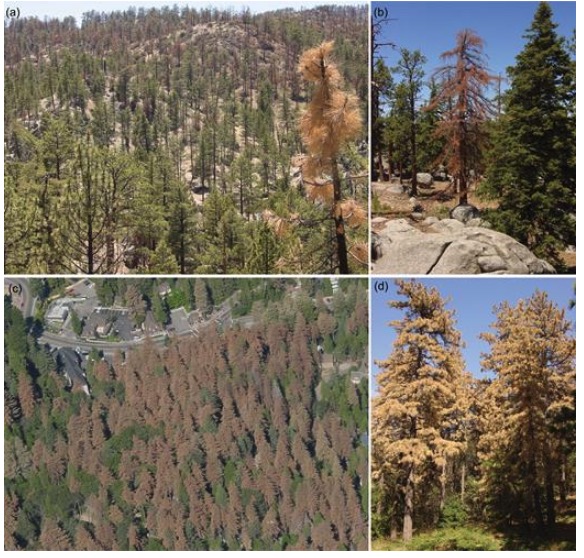This week a group of nine scientists and researchers published the results of their work considering how unusually high tree mortality affects wildfires in California’s Sierra Nevada forests that over thousands of years have adapted to frequent fire. They point out that fire suppression-caused forest densification has increased competition among trees for water and other resources, destabilizing many frequent fire forests by making them prone to mortality from other agents such as bark beetles.
Authors
Scott L. Stephens, Brandon M. Collins, Christopher J. Fettig, Mark A. Finney, Chad M. Hoffman, Eric E. Knapp, Malcolm P. North, Hugh Safford, Rebecca B. Wayman
The abstract and conclusions are below. The entire paper can be accessed at the US Forest Service website. The illustrations are from the document.
Abstract
Massive tree mortality has occurred rapidly in frequent-fire-adapted forests of the Sierra Nevada, California. This mortality is a product of acute drought compounded by the long-established removal of a key ecosystem process: frequent, low- to moderate-intensity fire. The recent tree mortality has many implications for the future of these forests and the ecological goods and services they provide to society. Future wildfire hazard following this mortality can be generally characterized by decreased crown fire potential and increased surface fire intensity in the short to intermediate term. The scale of present tree mortality is so large that greater potential for “mass fire” exists in the coming decades, driven by the amount and continuity of dry, combustible, large woody material that could produce large, severe fires. For long-term adaptation to climate change, we highlight the importance of moving beyond triage of dead and dying trees to making “green” (live) forests more resilient.


[…]
Conclusions
Unprecedented Sierra Nevada tree mortality has rapidly occurred after a severe drought with effects compounded by forest densification from decades of fire suppression. In the central and southern Sierra Nevada some areas have experienced more than 90% tree mortality, producing extensive landscapes of standing dead trees. This differs from mortality resulting from stand-replacing wildfire because bark beetles do not reduce surface fuels or jumpstart succession of shade-intolerant, fire-resistant pines. Forest managers have been struggling to determine whether these new postmortality conditions will increase wildfire intensity and/or severity, what the near- and long-term effects on forest communities will be, and what the appropriate intervention measures are.
In the first decade, wildfire severity in bark beetle killed frequent fire (FF) forests may be little affected over current conditions. Other than a brief increase during the “red phase” when most dead needles are still on recently killed trees, the reduction in canopy fuels is counterbalanced by an increase in surface fuels (figure 2). However, these are no grounds for complacency because current conditions in the majority of mixed-conifer and yellow pine forests in California already consist of unnaturally high surface fuel loads and corresponding elevated fire hazards (figure 2; Lydersen et al. 2014, Stephens et al. 2015).
The more troubling projection is how extensive loading of large-sized woody fuels in future decades may contribute to dangerous mass fires beyond the predictive capacity of current fire models. These fires can generate their own wind and weather conditions and create extensive spotting, making fire behavior and its impact on structures and public safety difficult to manage and predict. In addition, such intense fires could prevent forests from becoming re-established. Lacking the legacy of live trees that historic FF would have left (Stephens et al. 2008), large unburned areas of dead trees may also produce unusual forest succession patterns. These patterns will likely favor shade-tolerant and hardwood tree regeneration, limited shrub growth, and accumulating large woody fuels that would likely kill regenerating forests when wildfire inevitably occurs. The scale of contiguous tree mortality entrenches the homogeneity produced by fire suppression, reducing the fine-scale heterogeneity of forest conditions that contributes to resilience and biodiversity. Management could enhance adaptation to climate-change-induced stress if it focused more of its resources on creating spatially and temporally variable patterns in green FF forests that are better aligned with local moisture availability and fire patterns (North et al. 2009).
Many of our FF forests have failed to receive the very management that could increase resilience to disturbances exacerbated by climate change, such as the application of prescribed fire and mechanical restoration treatments (Stephens et al. 2016). Recent tree mortality raises serious questions about our willingness to address the underlying causes. If our society doesn’t like the outcomes from recent fires and extensive drought-induced tree mortality in FF forests, then we collectively need to move beyond the status quo. Working to increase the pace and scale of beneficial fire and mechanical treatments rather than focusing on continued fire suppression would be an important step forward.
